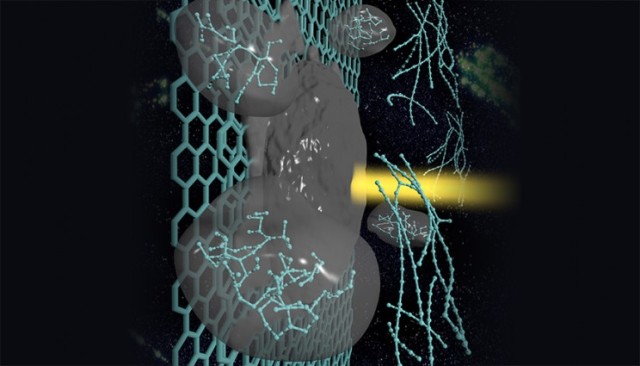Researchers at Lawrence Livermore National Laboratory (LLNL) have explored a method that uses laser-melted graphite to develop linear chains of carbon atoms.
 A carbyne strand forms in laser-melted graphite. Carbyne is found in astrophysical bodies and has the potential to be used in nanoelectronic devices and superhard materials. Image by Liam Krauss/LLNL
A carbyne strand forms in laser-melted graphite. Carbyne is found in astrophysical bodies and has the potential to be used in nanoelectronic devices and superhard materials. Image by Liam Krauss/LLNL
This material, referred to as carbyne, could possess numerous unique properties, such as modification of the quantity of electrical current passing through a circuit according to the needs of a user. This research could probably lead to the creation of tiny electronics capable of turning on and off at an atomic scale.
A lot of research activities are centered on carbyne as it is found in astrophysical bodies, and could be adapted for use in superhard materials and nanoelectronic gadgets. It has a stiffness 40 times greater than diamond, and possesses unique electrical properties due to its linear shape. These properties are sensitive to bending and stretching.
Carbyne can also be found in the Allende and Murchison meteorites, as well as in interstellar dust.
Nir Goldman, LLNL scientist and associate Christopher Cannella, a Caltech undergraduate summer researcher, applied computer simulations to analyze the properties of liquid carbon during evaporation. This liquid carbon was created by heating the surface of graphite with a laser beam to extremely high temperatures. Consequently, a moderately volatile droplet is created. The researchers were surprised to notice that the droplet created bunches of linear carbon atom chains when it was evaporated and cooled in the computer simulations.
“There’s been a lot of speculation about how to make carbyne and how stable it is,” Goldman said. “We showed that laser melting of graphite is one viable avenue for its synthesis. If you regulate carbyne synthesis in a controlled way, it could have applications as a new material for a number of different research areas, including as a tunable semiconductor or even for hydrogen storage.”
“Our method shows that carbyne can be formed easily in the laboratory or otherwise. The process also could occur in astrophysical bodies or in the interstellar medium, where carbon-containing material can be exposed to relatively high temperatures and carbon can liquefy.”
Direct comparison with experimental observations was made possible with Goldman’s research and computational simulations. The simulations can also assist in establishing parameters for synthesis of carbon-based materials possessing unusual properties.
“Our simulations indicate a possible mechanism for carbyne fiber synthesis that confirms previous experimental observation of its formation,” Goldman said. “These results help determine one set of thermodynamic conditions for its synthesis and could account for its detection in meteorites resulting from high-pressure conditions due to impact.”
The LLNL research work has been featured on the cover of the Journal of Physical Chemistry (September 17th edition).